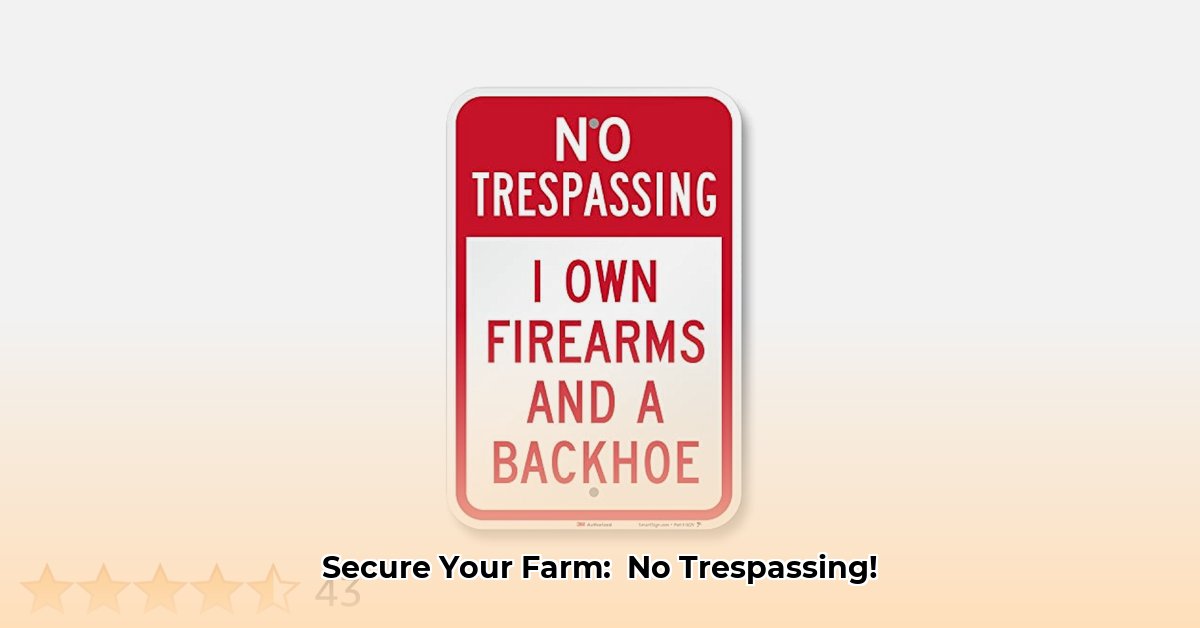
No Trespassing Signs Tractor Supply: Protecting Your Investment and Promoting Sustainability
Protecting your farm goes beyond simply cultivating crops; it involves safeguarding your assets and fostering a sustainable future. A vital, yet often overlooked, step is the strategic placement of "No Trespassing" signs. Readily available at Tractor Supply, these signs serve as a cornerstone of sustainable farming practices. But how effective are they in the long run, and what other steps are crucial for comprehensive farm security? For more information on Tractor Supply policies, check out their return policy.
Why Keeping Unauthorized Visitors Out is Essential for Sustainable Farming
Sustainable agriculture hinges on responsible resource management. Consider this: a single unauthorized vehicle traversing your fields can compact soil, hindering water absorption and diminishing crop yields. Thefts of produce or damage to equipment pose further significant risks. Clearly defined boundaries, enforced by visible "No Trespassing" signs, significantly mitigate these threats. It's a straightforward yet vital aspect of modern, sustainable farm management. "A well-defined perimeter, marked with clear signage, is the first line of defense against losses," notes Dr. Emily Carter, Agricultural Extension Specialist at Purdue University. This simple act contributes significantly to your farm's long-term health and sustainability. Do you want to risk losing months of hard work to a simple oversight?
Choosing the Right "No Trespassing" Sign: More Than Just Words
Tractor Supply offers various "No Trespassing" signs; choosing wisely is critical. Consider factors like sign size (ensuring visibility from a distance), material durability (for outdoor longevity), and clear, concise wording. Straightforward language avoids ambiguity. Strategic placement at all entry points, and potentially in areas prone to unauthorized access, is key. The aim? Crystal-clear communication preventing accidents and conflicts. What is the single most effective way to prevent theft?
Building a Comprehensive Farm Security Plan: A Multi-Layered Approach
While signs are a crucial starting point, a truly effective security strategy necessitates multiple layers of protection.
Fencing: Robust fencing, particularly around vulnerable areas or valuable equipment, provides a physical barrier against unwanted access.
Surveillance: Security cameras, even basic models, act as powerful deterrents. They provide a record of activity and discourage trespassers.
Regular Farm Patrols: Routine inspections of your property can identify potential issues early and deter potential intruders.
Community Engagement: Building positive relationships with neighbors creates a vigilant network, potentially alerting you to suspicious activity.
Legal Considerations: Understanding Your Rights and Responsibilities
While "No Trespassing" signs serve as warnings, understanding local trespass laws is crucial. These signs don't replace legal knowledge; consulting legal counsel ensures compliance and protects your interests.
How Farm Security Directly Supports Sustainable Practices
Protecting your property directly contributes to sustainable farming. Preventing unauthorized access protects your investment, conserves resources, and safeguards the long-term health of your land. It’s a fundamental tenet of responsible agriculture. This holistic approach reduces environmental impact and improves overall farm resilience. For example, preventing soil compaction from unauthorized vehicles directly supports soil health, a crucial aspect of sustainable farming.
Sustainable Practices & Property Protection: A Synergistic Relationship
| Sustainable Practice | Benefits of Property Protection |
|---|---|
| Water Conservation | Prevents damage to irrigation systems, maximizing water efficiency. |
| Soil Health | Minimizes soil compaction from unauthorized vehicles, preserving soil structure and fertility. |
| Crop Protection | Prevents theft or damage to crops, ensuring maximum yield and reducing food waste. |
| Biodiversity Conservation | Protects natural habitats from disturbance. |
| Reduced Chemical Use | Prevents unauthorized pesticide/herbicide use, reducing environmental pollution. |
Implementing robust farm security measures directly supports sustainable practices, creating a win-win situation for both your farm's profitability and the environment. The "No Trespassing" sign is the foundation of this strategy.
Implementing Precision Agriculture for Small Farms Sustainably
Precision agriculture (PA) employs technology to optimize farming practices, delivering the right inputs (water, fertilizer, pesticides) to the right location at the optimal time. This boosts efficiency, minimizes waste, and enhances environmental protection.
Understanding Precision Agriculture's Role in Sustainable Farming
For small farms, PA translates to higher profits and a reduced environmental footprint. However, successful implementation requires careful planning.
Step-by-Step Guide to Implementing Precision Agriculture
Farm Assessment: Identify key challenges and areas needing improvement.
Goal Setting: Begin with achievable goals, perhaps integrating GPS-guided machinery or soil sensors.
Technology Selection: Choose technology based on your budget and technical expertise, starting with affordable options.
Training & Education: Invest in thorough training to master selected technologies.
Data Management: Efficiently collect and analyze data to track progress and optimize practices.
Precision Agriculture and Sustainable Practices: A Natural Synergy
PA directly supports sustainable practices. Optimized resource use minimizes environmental impact: reduced fertilizer applications lessen runoff pollution, precise irrigation conserves water, and targeted pesticide use safeguards beneficial insects while decreasing chemical residues.
Overcoming Challenges in Implementing Precision Agriculture
While the benefits are significant, adopting PA requires addressing potential challenges. Initial investment costs can be substantial, and acquiring the necessary digital skills may be a hurdle. However, incremental steps, coupled with government assistance or training programs, can alleviate these obstacles.
Building a Sustainable Farming Future with Precision Agriculture
Precision agriculture is a long-term investment, not a quick solution. By strategically utilizing resources, selecting appropriate technologies, and embracing continuous learning, you can establish a robust, profitable, and environmentally responsible farm operation. Combine this with the physical security of "No Trespassing" signs and you're building a legacy, ensuring your farm's success for generations.